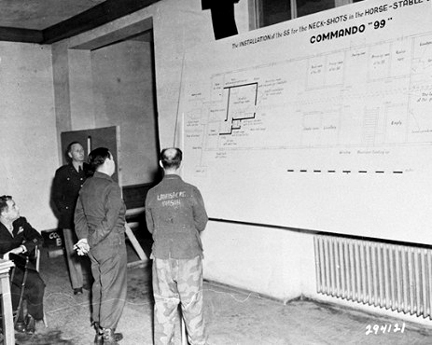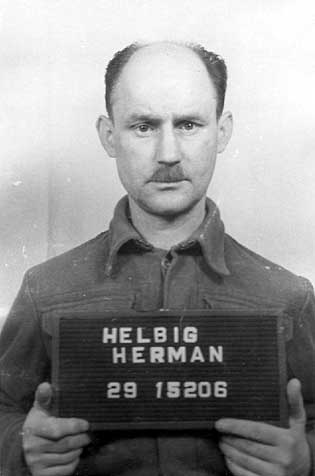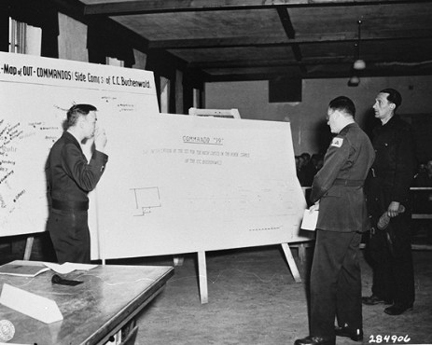Dachau Trials
US vs. Josias Erbprinz zu Waldeck-Pyrmont
Commando 99 - the execution of Soviet
Communist Commissars

Hermann Helbig points
out the place were Russian POWs were killed
The charge against all of the accused
in the main Buchenwald trial was participating in a "common
plan" to violate the Laws and Usages of War under the Geneva
Convention of 1929 and the Hague Convention of 1907. Under this
charge, one of the main crimes committed at Buchenwald was the
shooting of Soviet Prisoners of War, which was a violation of
the Geneva Convention.
The prosecution was of the opinion that
the defeated Germans should be held to the rules of the Convention
with regard to Soviet POWs, even though the victorious Army of
the Soviet Union, which had not signed the Geneva Convention,
had committed some of the most horrendous atrocities against
captured German soldiers, including sodomy and cannibalism, not
to mention the unspeakable actions of the Russian soldiers against
innocent German civilians.
At the time that the Buchenwald proceedings
were taking place, millions of German POWs were working as slave
laborers in the Russian gulags in Siberia. Only a few of them
survived this ordeal and finally returned home after 10 years
of working as slave laborers.
America had signed the 1929 Geneva Convention
and was responsible for treating German POWs according to the
rules of the Convention. However, in March 1945, General Dwight
D. Eisenhower had designated all captured German soldiers as
Disarmed Enemy Forces who were not entitled to be treated according
to the Geneva Convention. At the time that the Buchenwald trial
was taking place, the former Dachau concentration camp had been
turned into War
Crimes Enclosure No. 1 where German soldiers were being denied
their rights under the Geneva Convention.
Before the invasion of Russia on June
22, 1941, Hitler had ordered that all captured Russian soldiers
who were determined to be Communist Commissars were to be brought
to one of the major concentration camps and executed. Not all
of the Russian POWs were killed, just those who were political
functionaries. At Buchenwald, the work of executing the Communist
Commissars was done by a group called "Commando 99."
In the photograph above, Hermann Helbig
identifies the stable where Russian Commissars were shot. Helbig
was one of the executioners. Helbig's defense was that he had
been a soldier for 25 years, and that he was only carrying out
orders from his superiors. He said that he had no reason to question
the legality of the order.

Hermann Helbig
Hermann Pister, the Commandant of Buchenwald,
was charged by the Tribunal with being responsible for the executions,
although he wasn't present when the executions took place and
he was not the person who had given the orders. Under the "common
plan" theory, which was unknown in international law, Pister's
position as the camp Commandant was enough to make him automatically
guilty of a war crime with respect to the execution of the Russian
Commissars in his camp.
Rudolf Höss, the former Commandant
of Auschwitz, wrote the following in his autobiography, regarding
the execution of Soviet POWs who were Communist Commissars:
The reason for this action was given
as follows: the Russians were murdering any German soldier who
was a member of the Nazi party, especially SS members. Also,
the political section of the Red Army had a standing order to
cause unrest in every way in any POW camp or places where the
POWs worked. If they were caught or imprisoned, they were instructed
to perform acts of sabotage.

Horst Dittrich, on
the far right, testifies about Commando 99
According to Horst Dittrich, an SS man
who was a defendant in a subsidiary trial at Dachau, and a witness
for the prosecution at the main Buchenwald trial, the Russian
Commissars were killed by a shot fired through a slit in the
wall of a medical examination room set up in the horse stable
at Buchenwald. This horse stable had originally been built for
Ilse Koch, who loved to ride horses, to the accompaniment of
music played by an SS orchestra. The photograph above shows Horst
Dittrich as he points out the location of the room where the
Russian Commissars were executed. Dittrich had confessed during
his interrogation, so he was a valuable witness for the prosecution.

Measuring device with
slit through which shots were fired

Room where shooter
stood behind the slit in the measuring device
The measuring device which was allegedly
used to kill Russian Commissars was invented by the Commandant
at the Sachsenhausen concentration camp, according to the Russians
who liberated the Sachsenhausen camp. A film of the Sachsenhausen
camp was made by the Russians in which this method of execution
was explained. The horse stable at Buchenwald has long since
been torn down, but a reconstruction of the measuring device
is currently shown at the Buchenwald Memorial Site, as pictured
above. The measuring device used at Sachsenhausen is also long
gone, and there is no reconstruction of it.
Horst Dittrich had no explanation for
why this surreptitious and inefficient method of killing was
allegedly used to murder 8,000 Russians at Buchenwald, even though
the executions had been ordered by the Reich Security Main Office
on the authority of Adolf Hitler himself. Dittrich testified
that the room had to be cleaned with a water hose after each
execution. At Dachau, 6,000 Russian Commissars were allegedly
taken to a firing range outside the camp and executed.
Defense attorney Captain Emanuel Lewis
argued at the Buchenwald trial that "We think the language
of the Convention is simple and binding. It binds only those
nations who sign it as between themselves. It is not binding
as between a signatory and a nation that has refused to join
the family of nations."
The argument over whether Germany should
have been held to the rules of the Geneva convention with respect
to the Russians who had not signed the Convention and were not
following it, was never resolved in the Dachau courtroom. Another
argument by the prosecution was that the execution of the Russian
Commissars was murder because they had not been given a trial.
Hermann Pister, Commandant at Buchenwald,
pointed out in his testimony that many of his comrades had been
executed by the Allies without a trial. He claimed that Waffen-SS
Lt. Gen. Schmidt was summarily executed without a trial because
he was considered to be responsible for the horrible conditions
found in the Mauthausen concentration camp when it was liberated
by American troops, even though he was not in charge of the camp.
The Commandant of Mauthausen, Franz Ziereis, did not get a trial; he was
shot "while attempting to escape."
The former Dachau concentration camp
was a strange choice as the location for the proceedings of the
American Military Tribunals against German war criminals, who
had allegedly violated the Geneva Convention, because Dachau
was the site of the bloody massacre of surrendering Waffen-SS soldiers
who had no connection with the concentration camp next door to
their garrison.
Ilse
Koch - human lampshades
Dr.
Hans Eisele
Hans
Merbach
Sentences
of the guilty
Commandant
Hermann Pister
Back
to Buchenwald trial
Back to Dachau
Trials
Home
This page was last updated on September
14, 2009
Dachau TrialsUS vs. Josias Erbprinz zu Waldeck-PyrmontCommando 99 - the execution of Soviet Communist Commissars The charge against all of the accused in the main Buchenwald trial was participating in a "common plan" to violate the Laws and Usages of War under the Geneva Convention of 1929 and the Hague Convention of 1907. Under this charge, one of the main crimes committed at Buchenwald was the shooting of Soviet Prisoners of War, which was a violation of the Geneva Convention. The prosecution was of the opinion that the defeated Germans should be held to the rules of the Convention with regard to Soviet POWs, even though the victorious Army of the Soviet Union, which had not signed the Geneva Convention, had committed some of the most horrendous atrocities against captured German soldiers, including sodomy and cannibalism, not to mention the unspeakable actions of the Russian soldiers against innocent German civilians. At the time that the Buchenwald proceedings were taking place, millions of German POWs were working as slave laborers in the Russian gulags in Siberia. Only a few of them survived this ordeal and finally returned home after 10 years of working as slave laborers. America had signed the 1929 Geneva Convention and was responsible for treating German POWs according to the rules of the Convention. However, in March 1945, General Dwight D. Eisenhower had designated all captured German soldiers as Disarmed Enemy Forces who were not entitled to be treated according to the Geneva Convention. At the time that the Buchenwald trial was taking place, the former Dachau concentration camp had been turned into War Crimes Enclosure No. 1 where German soldiers were being denied their rights under the Geneva Convention. Before the invasion of Russia on June 22, 1941, Hitler had ordered that all captured Russian soldiers who were determined to be Communist Commissars were to be brought to one of the major concentration camps and executed. Not all of the Russian POWs were killed, just those who were political functionaries. At Buchenwald, the work of executing the Communist Commissars was done by a group called "Commando 99." In the photograph above, Hermann Helbig identifies the stable where Russian Commissars were shot. Helbig was one of the executioners. Helbig's defense was that he had been a soldier for 25 years, and that he was only carrying out orders from his superiors. He said that he had no reason to question the legality of the order.  Hermann Pister, the Commandant of Buchenwald, was charged by the Tribunal with being responsible for the executions, although he wasn't present when the executions took place and he was not the person who had given the orders. Under the "common plan" theory, which was unknown in international law, Pister's position as the camp Commandant was enough to make him automatically guilty of a war crime with respect to the execution of the Russian Commissars in his camp. Rudolf Höss, the former Commandant of Auschwitz, wrote the following in his autobiography, regarding the execution of Soviet POWs who were Communist Commissars: The reason for this action was given as follows: the Russians were murdering any German soldier who was a member of the Nazi party, especially SS members. Also, the political section of the Red Army had a standing order to cause unrest in every way in any POW camp or places where the POWs worked. If they were caught or imprisoned, they were instructed to perform acts of sabotage.  According to Horst Dittrich, an SS man who was a defendant in a subsidiary trial at Dachau, and a witness for the prosecution at the main Buchenwald trial, the Russian Commissars were killed by a shot fired through a slit in the wall of a medical examination room set up in the horse stable at Buchenwald. This horse stable had originally been built for Ilse Koch, who loved to ride horses, to the accompaniment of music played by an SS orchestra. The photograph above shows Horst Dittrich as he points out the location of the room where the Russian Commissars were executed. Dittrich had confessed during his interrogation, so he was a valuable witness for the prosecution. The measuring device which was allegedly used to kill Russian Commissars was invented by the Commandant at the Sachsenhausen concentration camp, according to the Russians who liberated the Sachsenhausen camp. A film of the Sachsenhausen camp was made by the Russians in which this method of execution was explained. The horse stable at Buchenwald has long since been torn down, but a reconstruction of the measuring device is currently shown at the Buchenwald Memorial Site, as pictured above. The measuring device used at Sachsenhausen is also long gone, and there is no reconstruction of it. Horst Dittrich had no explanation for why this surreptitious and inefficient method of killing was allegedly used to murder 8,000 Russians at Buchenwald, even though the executions had been ordered by the Reich Security Main Office on the authority of Adolf Hitler himself. Dittrich testified that the room had to be cleaned with a water hose after each execution. At Dachau, 6,000 Russian Commissars were allegedly taken to a firing range outside the camp and executed. Defense attorney Captain Emanuel Lewis argued at the Buchenwald trial that "We think the language of the Convention is simple and binding. It binds only those nations who sign it as between themselves. It is not binding as between a signatory and a nation that has refused to join the family of nations." The argument over whether Germany should have been held to the rules of the Geneva convention with respect to the Russians who had not signed the Convention and were not following it, was never resolved in the Dachau courtroom. Another argument by the prosecution was that the execution of the Russian Commissars was murder because they had not been given a trial. Hermann Pister, Commandant at Buchenwald, pointed out in his testimony that many of his comrades had been executed by the Allies without a trial. He claimed that Waffen-SS Lt. Gen. Schmidt was summarily executed without a trial because he was considered to be responsible for the horrible conditions found in the Mauthausen concentration camp when it was liberated by American troops, even though he was not in charge of the camp. The Commandant of Mauthausen, Franz Ziereis, did not get a trial; he was shot "while attempting to escape." The former Dachau concentration camp was a strange choice as the location for the proceedings of the American Military Tribunals against German war criminals, who had allegedly violated the Geneva Convention, because Dachau was the site of the bloody massacre of surrendering Waffen-SS soldiers who had no connection with the concentration camp next door to their garrison. Ilse Koch - human lampshadesDr. Hans EiseleHans MerbachSentences of the guiltyCommandant Hermann PisterBack to Buchenwald trialBack to Dachau TrialsHomeThis page was last updated on September 14, 2009 |